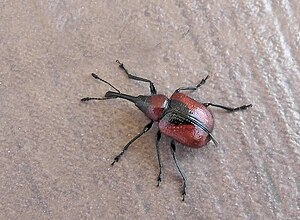Mecorhis ungarica
| Mecorhis ungarica | ||||||||||||
|---|---|---|---|---|---|---|---|---|---|---|---|---|

Mecorhis ungarica |
||||||||||||
| Systematics | ||||||||||||
|
||||||||||||
| Scientific name | ||||||||||||
| Mecorhis ungarica | ||||||||||||
| ( Autumn , 1784) |
Mecorhis ungarica is a small but very strikingly drawn beetle from the family of leaf rollers (Attelabidae), subfamily Triebstecher (Rhynchitinae), which belong to the weevils (in the broader sense) (superfamily Curculionoidea ). The occasionally used German names "Rosenknospenstecher" or "Rosenblütenstecher" are not clear, they are also used for other types of beetles on rose. A common scientific synonym is Rhynchites hungaricus , under this name the species is listed in most of the older lists.
features
The beetle reaches four to six millimeters in length. It is two-tone black and bright red. Usually the body, including the appendages, is black, the pronotum and the wing covers are red, with a wide black longitudinal stripe running on both sides of the suture on the wing covers, which is usually narrowed in a wedge shape towards the back. Deviations in color are common. Often there are one or two black bands on the pronotum. The black drawing can also be more extensive, up to completely black animals. The entire body is black haired protruding, whereby the hair is directed slightly backwards. The trunk is relatively long and straight. The antennae are turned in near the middle of the trunk, in the male slightly in front of the middle. The loosely structured, three-part antennae lobe is clearly set off from the antennae whip. The body is stocky, the pronotum is curved on the sides and significantly narrower than the elytra. On the wing covers there are coarse row dots, in between a confused dotting of the same thickness. On the rails (tibia) of the forelegs sit two hook-shaped thorns in both sexes.
Way of life
The larva of the species lives on roses (genus Rosa ). It occupies both wild and cultivated plants. The female lays an egg in a flower bud and then eats the flower stalk, which kinks and wilts. The larva eats inside the withered bud. With this she finally drops to the ground, where she pupates in a doll's chamber in the ground. Beetles can be seen from May to June.
distribution
It is a warmth-loving species that spreads from southern Central Europe across the Mediterranean to the Middle East. It has been found in Moravia and Slovakia and in the east of Austria (Lower Austria and Styria), but is absent in Germany. In countries with rose cultures, such as B. Turkey, it is considered a rose pest, but has no particular economic importance.
swell
- Lothar Dieckmann (1974): Contributions to the insect fauna of the GDR: Coleoptera- Curculionidae (Rhinomacerinae, Rhynchitinae, Attelabinae, Apoderinae) . Contributions to entomology: Contributions to the insect fauna of the GDR Vol. 24: 5–54, doi : 10.21248 / contrib.entomol.24.1-4.5-54 .
- GA Lohse: 3rd UFam. Attelabinae . In: H. Freude, KW Harde, GA Lohse (Ed.): Die Käfer Mitteleuropas . Volume 10. Goecke and Evers Verlag, Krefeld.